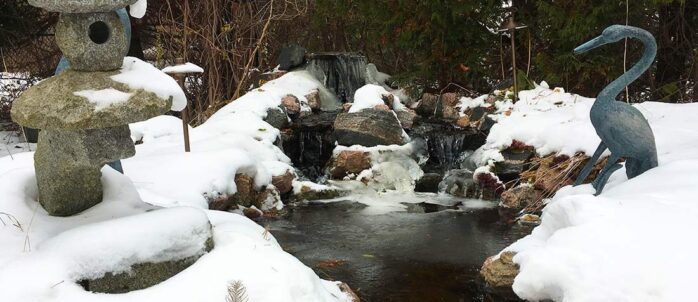
Keeping water clear and free of green goop during the cold months takes effort. The last thing anyone wants is a murky mess ruining the beauty of their outdoor space. With the right approach, a pond can stay balanced, clean, and healthy, even when temperatures drop.
Key Points:
- Remove organic debris before it decays.
- Control nutrients to prevent excessive algae growth.
- Use aeration to keep water moving and oxygen levels stable.
- Install a pond heater or de-icer if necessary.
- Monitor fish health and feeding habits.
- Invest in beneficial bacteria to break down waste naturally.
- Reduce excess sunlight exposure to discourage algae.
- Choose the right plants to aid in filtration.
Why Professional Help Makes a Difference
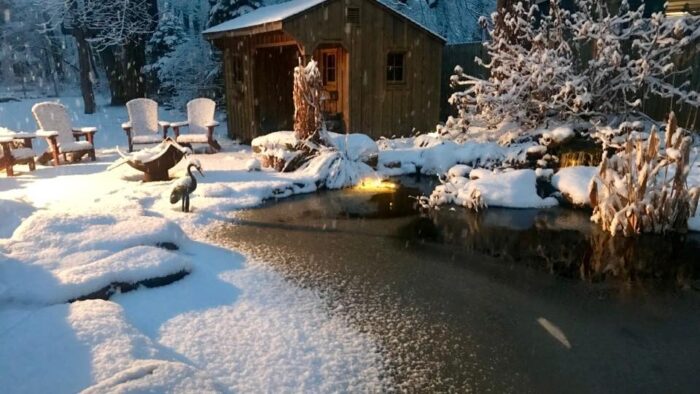
Sometimes, keeping water clear feels like an endless battle. That is when a pond specialist can be a game-changer. They offer solutions for cleaning, maintenance, and custom builds.
Having an expert’s guidance ensures the right approach for each unique setup. Whether it is a small backyard feature or a large koi habitat, professional input can prevent costly mistakes and long-term headaches.
Experts know exactly what conditions lead to murky water and excessive algae. With regular check-ups and tailored solutions, they can tackle problems before they spiral out of control.
Investing in the right help can mean less time spent struggling with water clarity and more time enjoying a healthy, thriving pond.
Preventing Algae Before It Becomes a Problem
Algae thrive on excess nutrients. The key to control is limiting available food sources. A few practical steps help:
- Skim leaves and debris before they break down.
- Reduce fish feeding to prevent excess waste.
- Use a high-quality filtration system.
- Introduce beneficial bacteria to digest organic matter.
- Limit direct sunlight exposure with floating plants or covers.
Waiting until the water turns green is a mistake. Taking action early makes a big difference. Once algae take hold, they are much harder to eliminate.
Keeping Oxygen Levels Steady During Cold Months
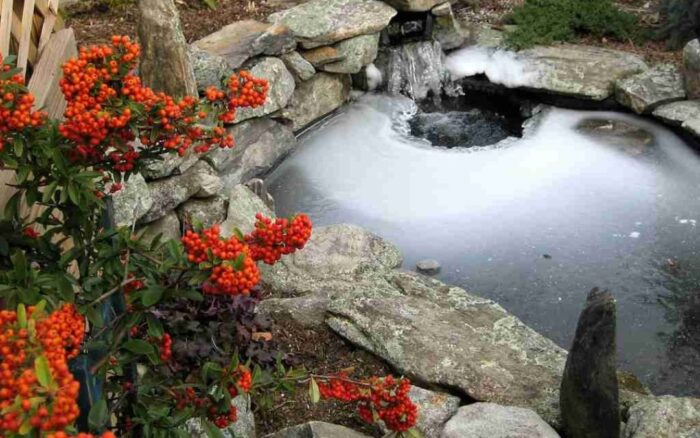
Oxygen levels drop when water freezes over. Stagnant water can suffocate aquatic life. The best ways to maintain circulation include:
- Adding an aerator to keep water moving.
- Installing a de-icer to prevent full surface freezing.
- Keeping a small waterfall or fountain operational.
Still water encourages decay and leads to more problems. Ensuring oxygen flow keeps the ecosystem stable, helping fish and beneficial bacteria survive even the coldest temperatures.
Fish Care in Cold Weather
Cold temperatures slow metabolism, making fish less active. Overfeeding becomes a risk since uneaten food leads to water quality issues. Guidelines for proper care include:
- Feeding only when necessary with temperature-appropriate food.
- Monitoring fish behavior for signs of distress.
- Avoiding netting or disturbing them unnecessarily.
Fish become sluggish during winter, which is completely normal. However, signs of distress, such as gasping for air, could indicate low oxygen levels. Keeping an eye on their behavior prevents small issues from becoming major problems.
The Role of Plants in Maintaining Balance
Plants absorb excess nutrients, making them natural filters. Good options for colder months include:
- Hardy water lilies that survive in lower temperatures.
- Submerged oxygenators to boost water clarity.
- Floating plants to block excessive sunlight.
During winter, some plants may die off, leaving more room for unwanted growth. Trimming back dead plant matter and keeping a few hardy species in place helps maintain water quality.
Essential Equipment to Keep Water Clear
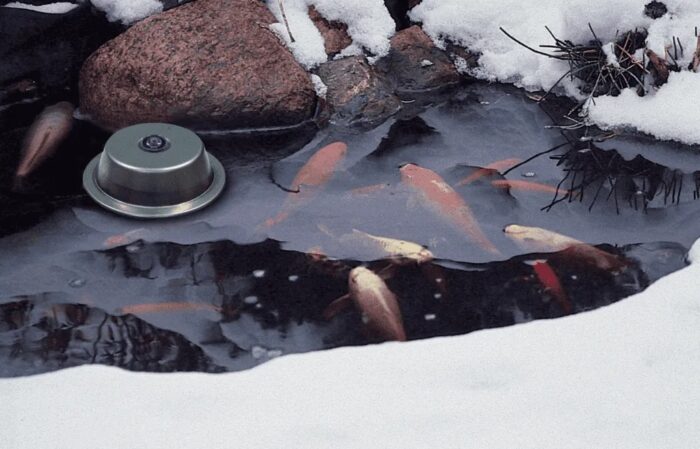
A few key tools make a huge difference in maintaining a clean aquatic environment:
- Pond netting: Stops leaves from accumulating.
- Aerators: Improves oxygen flow.
- Filtration systems: Traps debris and processes waste.
- De-icers: Prevents ice from completely sealing the surface.
Having the right equipment reduces maintenance time. A small investment in these tools can prevent major issues later.
Common Mistakes That Lead to Murky Water
Many pond owners make simple errors that create bigger problems. Avoiding the following ensures better water quality:
- Overfeeding fish, which increases waste buildup.
- Allowing leaves and debris to accumulate.
- Relying on chemical treatments instead of natural solutions.
- Ignoring the need for aeration.
Recognizing these mistakes makes maintenance much easier. A few proactive steps prevent unnecessary hassle and expense.
Using Beneficial Bacteria for a Natural Boost
Good bacteria help break down organic waste, preventing harmful buildup. Benefits include:
- Reducing sludge accumulation.
- Improving water clarity without harsh chemicals.
- Supporting overall ecosystem balance.
Adding these bacteria consistently keeps conditions stable throughout colder months. They work behind the scenes to process waste, ensuring a clean and healthy environment.
How to Keep Water Moving Even in Freezing Temperatures
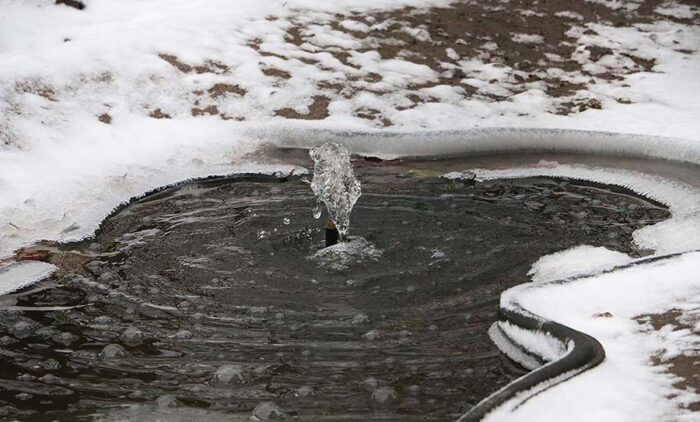
Standing water turns into stagnant water. That leads to more decay, more algae, and more overall problems. Keeping water flowing is key, and there are multiple ways to achieve that:
- Installing a waterfall or fountain that runs even in winter.
- Placing an air pump to circulate oxygen properly.
- Keeping a section of the surface ice-free with a de-icer.
A small movement in the water prevents the entire surface from freezing. That keeps oxygen flowing and ensures fish have a safe space to breathe.
The Impact of Winter Sunlight on Water Quality
Even in the cold, sunlight fuels algae growth. Without intervention, water turns green fast. Ways to reduce excessive sun exposure include:
- Using floating plants to create shade.
- Placing rocks or decorations to block direct sun rays.
- Installing a shade cloth for extra coverage.
Sunlight might feel weak during winter, but it still affects the balance of nutrients in the water. Keeping algae under control means managing sunlight exposure carefully.
Why Water Testing Should Not Be Ignored
Water quality changes rapidly when temperatures drop. Testing for pH, ammonia, and oxygen levels provides crucial insight into potential issues. Regular testing helps:
- Detect problems before they become severe.
- Adjust maintenance routines as needed.
- Ensure the water remains safe for fish and plants.
Skipping tests leads to surprises—most of them unpleasant. A quick check every few weeks saves a lot of trouble later.
Final Thoughts
A little effort goes a long way in keeping a pond healthy during colder months. Removing debris, controlling nutrients, and ensuring proper aeration prevent common issues.
Investing in the right equipment and using natural treatments simplifies maintenance. With these strategies, water stays clear, fish stay happy, and the entire ecosystem thrives no matter the season.





